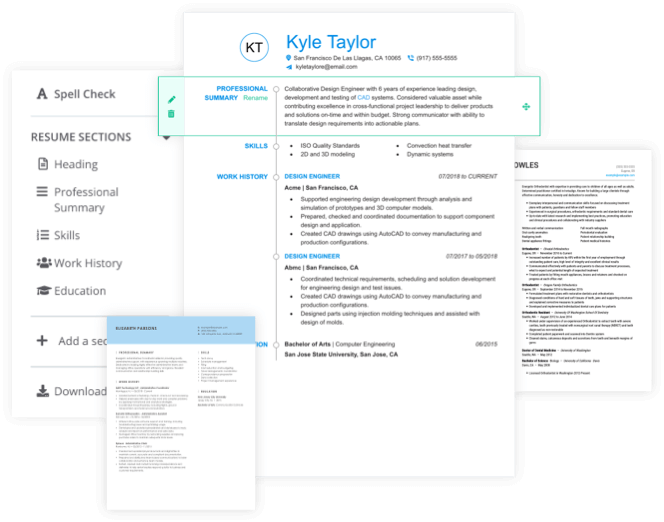- Featured in:

Electrical drafters prepare and draw technical drawings of wiring systems. They generally work on projects related to power transmission and generation, rather than on consumer-scale electrical projects. Electrical drafters tend to work closely with architects and engineers to develop specifications and translate them into functional documents that guide the installation and maintenance of electrical wiring. Many electrical drafters also develop specification sheets and documentation related to power transmission and wiring.
This role requires a thorough understanding of electrical transmission principles, along with the ability to analyze information and present it in a clear, accessible manner to guide electrical contracting work.
If you are having writers block, our resume examples can help. Choose from hundreds of job titles to find the right example for your needs.
Want to boost your resume? Your Jobhero subscription comes with a complimentary cover letter builder. Once you choose a cover letter template, the builder will suggest job-specific skills and prewritten entries, allowing you to save multiple letters for various applications fast.
Electrical Drafter Duties and Responsibilities
The typical duties of an electrical drafter can vary somewhat, but their core duties tend to involve:
Design and Draw Wiring Diagrams
Electrical drafters develop wiring diagrams throughout the project lifecycle. These diagrams include a master drawing that shows structures and wiring systems, as well as detail drawings illustrating electrical connections, distances, and landscape elements that need to be considered during the planning stage. Electrical drafters may also prepare drawings that illustrate wiring connections and equipment.
Calculate Material and Transmission Needs
Electrical drafters work closely alongside engineers, architects, and technicians to determine project specifications and functional requirements. They examine proposed sites and projects to determine power needs and generate estimates for materials, such as wire or underground pipes. Electrical drafters tend to work with engineers throughout a project, as power needs can change as work continues.
Develop Technical Specification Guides
Once they have gathered functional requirements for a power transmission project, electrical drafters develop and prepare technical specification guidelines. They may assemble a series of documents to guide installation and maintenance of electrical lines. This requires a high level of attention to detail, as electrical drafters check technical documents to ensure a high level of accuracy.
Direct Electrical Installers
Electrical drafters also work closely with contractors and installers throughout the project lifecycle. Early in the process, they review documents and diagrams with installers, answering questions related to materials or power needs. Later, they inspect contractors' work to ensure they are following diagrams and adhering to specifications.
Resolve Electrical Planning Issues
Finally, electrical drafters collaborate with technicians, engineers, and contractors to resolve electrical issues that arise during the project lifecycle. For example, a contractor may inform an engineer that he is unable to follow the current specifications due to unforeseen circumstances; the electrical drafter will revise the drawings and return them to the engineer for approval.
Electrical Drafter Skills and Qualifications
Electrical drafters are highly technical and very familiar with electrical generation and transmission principles and best practices. Drafters should have at least an associate’s degree, along with the following skills:
- Electrical design - electrical drafters need a strong sense of electrical design, especially regarding power transmission over long distances
- Drafting skills - because electrical drafters spend most of their time developing and designing schematics and drawings, they also need extensive training in both hand- and computer-aided drafting
- Collaborative skills - electrical drafters tend to work with teams of engineers, architects, and technicians, along with contractors and installers, frequently collaborating throughout the design and installation process
- Problem-solving skills - electrical drafters frequently revise drawings based on changing power needs or equipment that impedes transmission
- Communication skills - electrical drafters communicate with architects, engineers, and contractors throughout the planning and installation process
Tools of the Trade
Electrical drafters tend to work in office settings, but they may also need to visit sites to provide guidance, take measurements, or inspect components. They should be able to use standard office software in addition to the following:
Computer-aided drafting (CAD) software (AutoCAD, SketchUp)
Electrical Drafter Education and Training
Most electrical drafters have at least an associate’s degree in a related field. This is typically a two-year program that provides instruction on drawing and preparing schematics, as well as providing a background in math and science. Electrical drafters can expand their earnings and career potential with certification through the American Design Drafting Association (ADDA), which offers an online test covering the principles of drafting and design.
Electrical Drafter Salary and Outlook
According to the Bureau of Labor Statistics (BLS), electrical drafters earned an average annual salary of $59,970 as of May 2016. This is slightly higher than the median salary for all drafting professionals, which was $53,480.
Employment for electrical drafters is expected to grow at an average pace between 2016 and 2026, with the BLS estimating seven percent growth.

Helpful Resources
If you’d like more information about working as an electrical drafter, we found several resources on the web for further information:
American Design Drafting Association (ADDA)
The ADDA provides certification and professional development for drafting professionals across industries.
Electrical Power Transmission System Engineering: Analysis and Design
Read this book to learn about the principles and math behind electric power transmission and generation.
4 Proven Strategies to Become a Better Drafter
This article provides tips and advice for improving drafting techniques and honing technical skills.
Mechanical and Electrical Systems in Architecture, Engineering and Construction
This textbook details the mechanical and electrical systems of residential, commercial, and construction buildings.
Electrical Drafter Resume Help
Explore these related job titles from our database of hundreds of thousands of expert-approved resume samples:




